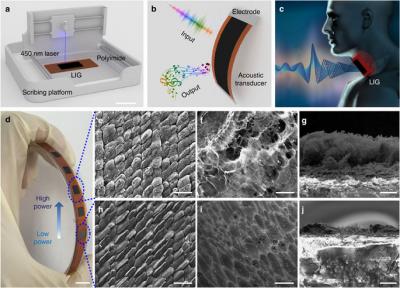Researchers at the China-based Tsinghua University have designed an intelligent artificial throat device using laser-induced graphene that can generate and detect sound. Many technologies have been developed to help vocally-impaired people, but most rely on alternatives to speech instead of actual vocal expression. These are also quite expensive and complex. The researchers in this study have developed a one-step process to fabricate a low-cost and wearable LIG artificial throat, that exhibits a high performance for both generating and detecting sounds. It is the LIG within the device, which possesses fantastic thermoacoustic and piezoresistive properties, that enables the functional integration of emitting and detection within a single device.

As a sound source, the device can generate a wide-band sound source with a frequency of 100 Hz to 40 kHz. The device also has a broad frequency spectrum due to resonance-free oscillations from the sound sources. As a detector, the artificial throat device shows a unique response towards different kinds of sounds and throat vibrations. The device can recognize vocal activities such as coughing, humming and screaming at different tones and volumes, through the mechanical vibrations of the throat cords with fine repetition. This recognition is performed with clear distinction due to the differentiation of their specific waveforms. It also has the capability to recognize words and sentences. The different volumes and/or frequencies can be transformed into controllable and pre-designed sounds. The excellent mechanical properties of the device also allow the device to be capable of voice recognition.
The team used laser scribing, an established technique that has contributed to the fabrication of many graphene-based devices which allows for large scale and customizable patterns to be developed. However, the preparation is complex so a method of converting graphene oxide and polyimide (PI) into a porous graphene sheet, i.e. laser-induced graphene (LIG), was utilized.
The artificial throat has potential applications in assisting the disabled. The device’s ability to generate volume and frequency by the detection of different hums, allows the device to turn a meaningless hum into a controllable sound. This feature provides many practical applications. The simple one-step process makes the device a commercial and scalable prospect. There are many applications where the device could be implemented in the future, including voice control, voice recognition and wearable electronics.